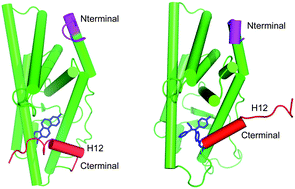Phytoestrogens are plant compounds that mimic the actions of endogenous estrogens. The abundance of these chemicals in nature and their potential effects on health require the development of a convenient method to detect phytoestrogens. We have developed a nanoparticle (NP)-conjugated FRET probe based on the human estrogen receptor α (ER) ligand-binding domain (LBD) to detect phytoestrogens. The NP-conjugated FRET probe showed fluorescence signals for genistein, resveratrol and daidzein compounds with Δ ratios of 1.65, 2.60 and 1.37 respectively, which are approximately six times greater compared to individual FRET probes. A significantly higher signal for resveratrol versus genistein and daidzein indicates that the probe can differentiate between antagonistic phytoalexin substances and agonistic isoflavone compounds. NP-conjugated probes demonstrated a wide dynamic range, ranging from 10−18 to 10−1 M with EC50 values of 9.6 × 10−10, 9.0 × 10−10 and 9.2 × 10−10 M for genistein, daidzein and resveratrol respectively, whereas individual probes detected concentrations of 10−13 to 10−4 M for phytoestrogens compounds. The time profile revealed that the NP-conjugated probe is stable over 30 h and there is not a significant deviation in the FRET signal at room temperature. These data demonstrate that conjugation of a FRET probe to nanoparticles is able to serve as an effective FRET sensor for monitoring bioactive compounds with significantly increased sensitivity, dynamic range and stability.

You have access to this article
 Please wait while we load your content...
Something went wrong. Try again?
Please wait while we load your content...
Something went wrong. Try again?


 Please wait while we load your content...
Please wait while we load your content...